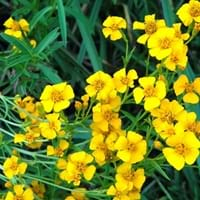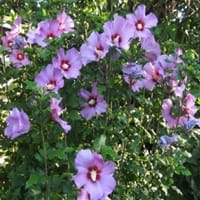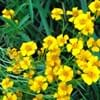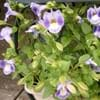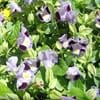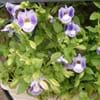Life Span
Annual
Perennial
Type
Flowering Plants, Shrubs
Shrub
Origin
Mexico, Central America
Australia
Types
African or American Marigolds, French Marigolds, Mule Marigolds
Not available
Number of Varieties
Not Available
Habitat
Roadsides, wastelands
subtropical regions, Temperate Regions, Tropical regions, Warmer regions
USDA Hardiness Zone
9-11
9-11
AHS Heat Zone
12 - 1
12-1
Sunset Zone
A1, A2, A3, H1, H2, 1a, 1b, 2a, 2b, 3a, 3b, 4, 5, 6, 7, 8, 9, 10, 11, 12, 13, 14, 15, 16, 17, 18, 19, 20, 21, 22, 23, 24
H1, H2, 13, 14, 15, 16, 17, 20, 21, 22, 23, 24
Habit
Upright/Erect
Upright/Erect
Flower Color
Yellow, Orange, Gold, Ivory
Blue, Purple, Blue Violet
Flower Color Modifier
Bicolor
Not Available
Fruit Color
Not Available
Not Available
Leaf Color in Spring
Dark Green
Dark Green
Leaf Color in Summer
Dark Green
Dark Green
Leaf Color in Fall
Dark Green
Dark Green
Leaf Color in Winter
Light Green
Dark Green
Leaf Shape
Toothed
Irregular
Plant Season
Summer, Fall
Spring, Summer, Fall, Winter
Sunlight
Full Sun
Full Sun
Growth Rate
Very Fast
Medium
Type of Soil
Clay, Loam, Sand
Clay, Loam, Sand
The pH of Soil
Neutral, Alkaline
Acidic, Neutral, Alkaline
Soil Drainage
Well drained
Well drained
Bloom Time
Indeterminate
Indeterminate
Tolerances
Drought
Not Available
Where to Plant?
Container, Ground, Pot
Ground, Pot
How to Plant?
Seedlings
Seedlings, Semi-hardwood cuttings
Plant Maintenance
Medium
Medium
Watering Requirements
Allow to dry out slightly between watering
Average Water Needs, Do Not over Water, Requires regular watering
In Summer
Lots of watering
Lots of watering
In Spring
Moderate
Moderate
In Winter
Average Water
Average Water
Soil pH
Alkaline, Neutral
Acidic, Neutral, Alkaline
Soil Type
Clay, Loam, Sand
Clay, Loam, Sand
Soil Drainage Capacity
Well drained
Well drained
Sun Exposure
Full Sun
Full Sun
Pruning
Prune ocassionally, Remove dead or diseased plant parts, Requires little pruning
Remove damaged leaves, Remove dead branches, Remove dead leaves
Fertilizers
All-Purpose Liquid Fertilizer
All-Purpose Liquid Fertilizer
Pests and Diseases
Alternaria Leaf Spot, Bacterial leaf spot, Damping-off, Gray mold, Powdery mildew, Root rot
Red blotch, Rust aphids
Plant Tolerance
Drought
Not Available
Flower Petal Number
Single, Double, Semi-Double
Single
Fragrant Bark/Stem
Yes
No
Foliage Texture
Coarse
Medium
Foliage Sheen
Matte
Matte
Attracts
Butterflies
Butterflies, Flying insects, Hummingbirds, Insects
Allergy
Not Available
Not Available
Aesthetic Uses
Showy Purposes
Borders, Showy Purposes, small hedge
Beauty Benefits
Not Available
Not Available
Environmental Uses
Air purification
Air purification
Medicinal Uses
Burns, constipation, Inflammation, Upset stomach, Wounds
High blood pressure, lowering blood pressure
Part of Plant Used
Flowers, Seeds
Flowers, Leaves
Other Uses
Can be made into a herbal tea, Decoration Purposes, Used As Food
Decoration Purposes
Used As Indoor Plant
Yes
Yes
Used As Outdoor Plant
Yes
Yes
Garden Design
Flower borders
Container, Feature Plant, Hedges, Mixed Border, Rock Garden, Wall
Botanical Name
Tagetes lucida
ALYOGYNE huegelii 'Monle'
Common Name
sweetscented marigold, Mexican marigold
Blue Hibiscus, Purple Delight Blue Hibiscus
In Hindi
sweetscented marigold
Blue Hibiscus
In German
süß duftend Ringelblume
Blauer Hibiskus Baum
In French
Yauhtli
Bleu Hibiscus Arbre
In Spanish
pericón, Santa María, yerbanís
Azul árbol del hibisco
In Greek
γλυκό άρωμα κατιφέ
Μπλε Hibiscus Tree
In Portuguese
Tarragon Mexicano
Árvore azul do hibiscus
In Polish
słodkie pachnące nagietka
Niebieski Hibiscus Drzewo
In Latin
sweetscented marigold
Hibiscus lignum blue
Phylum
Tracheophyta
Magnoliophyta
Class
Magnoliopsida
Magnoliopsida
Family
Asteraceae
Malvaceae
Clade
Not Available
Angiosperms, Eudicots, Rosids
Tribe
Not Available
Hibisceae
Subfamily
Not Available
Malvoideae
Number of Species
Not Available
Importance of Sweetscented Marigold and Blue Hibiscus
Want to have the most appropriate plant for your garden? You might want to know the importance of Sweetscented Marigold and Blue Hibiscus. Basically, these two plants vary in many aspects. Compare Sweetscented Marigold and Blue Hibiscus as they differ in many characteristics such as their life, care, benefits, facts, etc. Every gardener must at least have the slightest clue about the plants he wants to plant in his garden. Compare their benefits, which differ in many ways like facts and uses. The medicinal use of Sweetscented Marigold is Burns, constipation, Inflammation, Upset stomach and Wounds whereas of Blue Hibiscus is High blood pressure and lowering blood pressure. Sweetscented Marigold has beauty benefits as follows: Not Available while Blue Hibiscus has beauty benefits as follows: Not Available.
Compare Facts of Sweetscented Marigold vs Blue Hibiscus
How to choose the best garden plant for your garden depending upon its facts? Here garden plant comparison will help you to solve this query. Compare the facts of Sweetscented Marigold vs Blue Hibiscus and know which one to choose. As garden plants have benefits and other uses, allergy is also a major drawback of plants for some people. Allergic reactions of Sweetscented Marigold are Not Available whereas of Blue Hibiscus have Not Available respectively. Having a fruit bearing plant in your garden can be a plus point of your garden. Sweetscented Marigold has no showy fruits and Blue Hibiscus has no showy fruits. Also Sweetscented Marigold is not flowering and Blue Hibiscus is flowering. You can compare Sweetscented Marigold and Blue Hibiscus facts and facts of other plants too.
